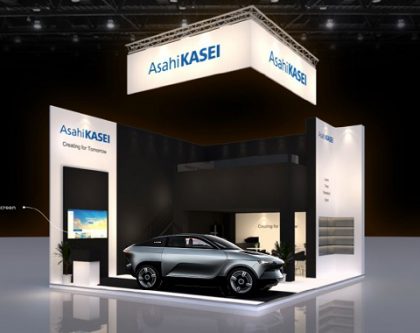Lightweight materials to make future mobility work. Today Oct. 16th., Asahi Kasei presented engineering plastics and foam materials for the automotive industry at its stand at the K 2019. One Highlight at the booth is the fully drivable electric concept car AKXYTM .
Lightweight materials will significantly add to the vehicle of the future. From the manufacturer’s point of view lightweight materials are first and foremost a key factor to achieve the CO2 fleet emission goals. At the same time, they contribute to a better range or fuel efficiency – without compromising safety. To reduce weight not only metals can be replaced, also existing plastic applications can be downsized and redesigned by using newly developed or improved thermoplastics.
The Japanese technology company Asahi Kasei is exhibiting its broad range of high-performance polymers and foam materials at K 2019. The company’s concept car AKXYTM is now on the focus of this year’s presentation, showing the broad range of automotive applications including synthetic rubber, electronics, fibers or coatings.
The so called company is also presenting the following materials:
TENACTM Polyacetal (POM) – Can you smell the difference?
The in-cabin air quality is becoming increasingly important. With the increased use of plastics inside the car, the reduction of VOCs (volatile organic compounds) is becoming a key factor for an improved in-car air quality. VOCs are carbon-based gases that can evaporate from plastic materials into the air at room temperature, especially in newly produced cars. In closed environments, these substances can lead to discomfort and health issues, such as headaches or nausea.
Asahi Kasei, the world’s only manufacturer of homo- and copolymer POM under the brand name TENACTM, developed a low-VOC material many years before the automotive industry started in-depth to address this issue. TENACTM has the world’s lowest VOC emission class – exceeding the high standards of all OEMs worldwide. In addition, properties like low friction, scratch resistance and a high mechanical strength make TENACTM a suitable material for applications in the automotive interior.
It is already used in applications like sliders for seat adjustments, lumbar supports for seating comfort, or seat belt push buttons. The company has recently developed a metal-looking low-VOC TENACTM, using aluminum flakes as a filler. Looking and feeling like metal, it features a high scratch resistance while at the same time improving the in-car air quality compared to other materials.
Thermylene® Polypropylene (PP) – The economic alternative Considering the concept of autonomous vehicles, panoramic roofs allow more light inside and offer excellent views of the surrounding to the passengers. Asahi Kasei’s glass reinforced polypropylene Thermylene® features a high flowability and offers cost advantages compared to polyamide. Lighter and larger sunroof panels made of this material will add to the overall living-space experience of the future automotive.
LEONATM Polyamide (PA) – Looks good, lasts long
With more sunlight inside the car, the necessity for UV-resistant materials will grow. Asahi Kasei’s semi-aromatic glass-filled polyamide LEONATM withstands the toughest automotive exterior UV tests – without any additional coating. It is used for exterior mirror brackets – and is now finding its way inside the car. It is already used for the fine thin-walled and unpainted blades of a dashboard venting system, directly positioned under the front windshield and with maximum sunlight exposure.
Polyamide Foam (under development) – The sound of silence
Sound insulation will become a key factor for the living-space experience inside the car. Ambient noise will need to be kept outside, while loud music should stay inside the car. Based on its expertise as one of only four fully integrated polyamide manufacturers Asahi Kasei is currently developing the world’s first polyamide bead foam. Featuring the proven properties of polyamide – like high heat and chemical resistance – the special C- or macaroni shape of its beads also enable a significant noise reduction.
XYRONTM (mPPE) – For structural battery parts
Applications for XYRON™ are to be found to a large extent in the automotive sector. Thanks to its low density – the lowest among engineering plastics – mPPE (modified polyphenylene ether) is suitable for a wide range of lightweight components, that are used, for example, for relay blocks, hood panels and brackets. Concerning the current period of upheaval in the automotive sector, XYRON™ is especially used in the context of structural battery parts in the field of e-mobility. In this regard, the material contributes to a compact and weight saving battery design, at the same time leading to more efficiency as well as safety.
SunForceTM (mPPE particle foam) – For improved safety and efficiency
SunForceTM is a particle foam based on the engineering plastic m-PPE. Compared to standard foams made of polystyrene or polyolefin, the use of m-PPE equips this foamed material with unique properties, opening new doors for applications in thermal management and fire protection. The material is certified with UL 94 V-0 (Standard for Safety of Flammability of Plastic Materials for Parts in Devices and Appliances) fire protection class by the Underwriters Laboratories safety certification organization and thus contributes to an overall product safety. SunForce™ is the first-of-its-kind material certified with the UL94 V-0 standard. In addition to this outstanding flame retardancy, the material provides superior heat insulation properties while at the same time functions as a lightweight shock-absorbing material for automotive battery packs.
The related article about “Asahi Kasei” published at PIMI news channel was: New Lightweight Material for Increased Efficiency of Electric Vehicle Batteries












